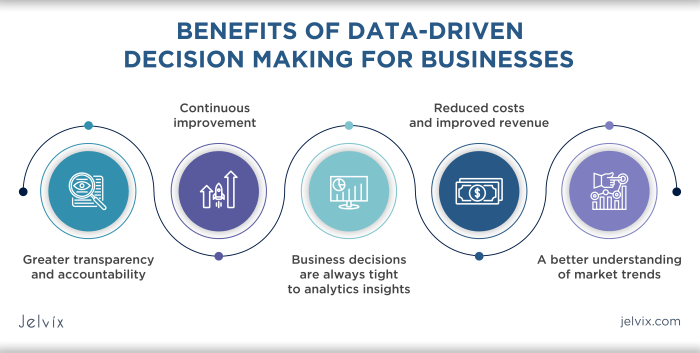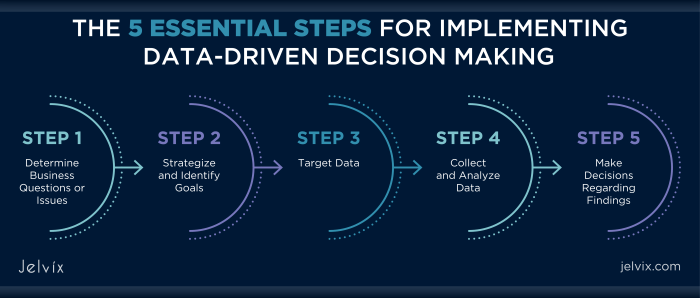Data-Driven Decision Making takes center stage, inviting readers into a world of informed choices and strategic moves that can transform businesses. As data becomes the driving force behind critical decisions, the possibilities for growth and success are endless.
From analyzing market trends to optimizing operational processes, the power of data-driven decision making is unparalleled in today’s fast-paced business landscape.
Definition of Data-Driven Decision Making
Data-driven decision making in business or organizations refers to the process of making informed choices based on data analysis rather than relying solely on intuition or gut feeling. It involves collecting, analyzing, and interpreting data to gain insights that guide strategic decisions and actions.
Examples of Data-Driven Decision Making
- Using customer purchase data to personalize marketing campaigns and improve customer retention rates.
- Analyzing website traffic data to optimize user experience and increase conversion rates.
- Utilizing employee performance data to identify training needs and enhance productivity in the workplace.
The Importance of Leveraging Data for Informed Decisions, Data-Driven Decision Making
By leveraging data to make decisions, organizations can:
- Identify trends and patterns that may not be apparent through traditional methods.
- Reduce risks by basing decisions on concrete evidence rather than assumptions.
- Improve efficiency and effectiveness by aligning strategies with actual data-driven insights.
Benefits of Data-Driven Decision Making
Data-driven decision making brings a whole new level of power to the table. By leveraging data to inform decisions, organizations can unlock a plethora of advantages that can propel them ahead of the competition.
Improved Efficiency and Productivity
- Data-driven decisions enable organizations to streamline processes and identify inefficiencies more effectively. By analyzing data on key performance indicators (KPIs) and operational metrics, businesses can pinpoint areas for improvement and optimize workflows for maximum productivity.
- Through data-driven insights, organizations can make informed decisions about resource allocation, staffing levels, and project timelines. This leads to a more efficient use of resources and a boost in overall productivity.
- By utilizing data to track progress and measure outcomes, businesses can quickly adapt strategies and tactics based on real-time feedback. This agility is crucial in today’s fast-paced business environment and can give organizations a competitive edge.
Enhanced Business Performance and Competitiveness
- Data-driven decisions provide a solid foundation for strategic planning and forecasting. By analyzing historical data and trends, organizations can make more accurate predictions about future market conditions and customer behavior.
- With data-driven insights, businesses can identify new opportunities for growth and innovation. By leveraging data to understand customer preferences and market trends, organizations can develop products and services that resonate with their target audience.
- Data-driven decision making also allows organizations to measure the impact of their initiatives and campaigns. By tracking key metrics and analyzing performance data, businesses can fine-tune their strategies for optimal results and stay ahead of the competition.
Components of Data-Driven Decision Making

Data-driven decision-making involves several key components that are crucial for the process to be successful. These components include data collection, analysis, interpretation, and the use of technology and tools to facilitate the decision-making process.
Data Collection
Data collection is the first step in the data-driven decision-making process. It involves gathering relevant information from various sources such as databases, surveys, sensors, and other sources. The quality and quantity of data collected are essential for making informed decisions.
Data Analysis
Once data is collected, the next step is data analysis. This involves organizing, cleaning, and transforming the data to extract meaningful insights. Statistical methods, machine learning algorithms, and data visualization techniques are often used to analyze the data effectively.
Data Interpretation
Data interpretation is the process of making sense of the analyzed data and drawing conclusions from it. This step requires domain knowledge and expertise to understand the implications of the data analysis results and make informed decisions based on the findings.
Role of Technology and Tools
Technology and tools play a crucial role in facilitating data-driven decision-making. Advanced analytics tools, data visualization software, and business intelligence platforms help organizations process and analyze large volumes of data efficiently. These tools enable decision-makers to visualize trends, patterns, and insights that can inform strategic decisions.
Challenges of Implementing Data-Driven Decision Making
In the journey towards implementing data-driven decision making, organizations often encounter various challenges that can hinder their progress and success in leveraging data effectively to make informed decisions.
Data Quality Concerns
Ensuring the accuracy, completeness, and reliability of data is a significant challenge for organizations. Poor data quality can lead to flawed insights and decisions, ultimately impacting the overall effectiveness of data-driven strategies.
Privacy and Security Issues
Maintaining the privacy and security of data is crucial in the era of data-driven decision making. Organizations must navigate the complexities of data protection regulations and ensure that sensitive information is safeguarded against breaches and unauthorized access.
Cultural Barriers to Adoption
Shifting towards a data-driven culture can be met with resistance from employees who are accustomed to traditional decision-making processes. Overcoming cultural barriers and fostering a mindset that values data-driven insights is essential for successful implementation within an organization.
Best Practices for Effective Data-Driven Decision Making

When it comes to making data-driven decisions, there are several best practices that can help organizations overcome challenges and maximize the benefits of utilizing data effectively.
Setting Clear Goals and Metrics
One of the most important best practices for effective data-driven decision making is setting clear goals and metrics for data analysis. By clearly defining what you want to achieve and how you will measure success, you can ensure that your data analysis efforts are focused and impactful.
Examples of Successful Implementation
Several organizations have successfully implemented data-driven decision-making practices to improve their operations and outcomes. For example, a retail company used customer data analysis to personalize marketing campaigns, resulting in increased sales and customer satisfaction. Another example is a healthcare provider that utilized data analytics to optimize patient care delivery, leading to improved health outcomes and cost savings.






